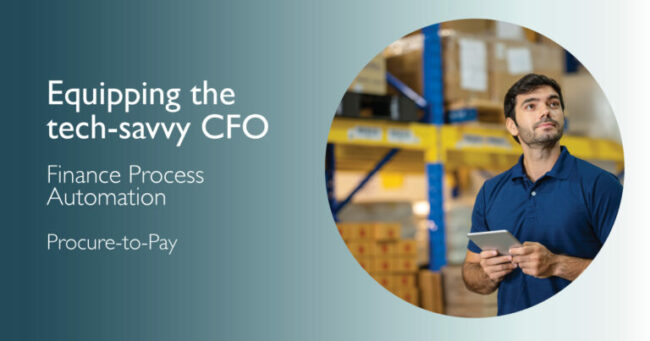This is part one of our Finance Process Automation blog series, in which we will examine three finance processes that are ripe for automation: Procure-to-Pay; Order-to-Cash; Record-to-Report
Procure-to-Pay
Procure-to-pay – which links procurement and supplier management to the broader finance function – is probably not the most exciting item on your company’s agenda. But what is exciting is the potential that exists within Procure-to-Pay to reduce costs, improve governance, compliance, accuracy and supplier relationships, and create a better employee experience. The key to unlocking these benefits is automation.
Automation is not simply incorporating robotics and AIs in order to free employees from mundane, risk-prone activities. It encompasses a host of systems and technologies that will result in a more integrated, efficient and productive Procure-to-Pay process.
At iOCO we look at finance and procurement automation as tightly connected and an opportunity to drive value jointly. Within Procure-to-Pay we examine four sub-areas – procurement, supplier management, invoice processing, and discrepancy resolution – and identify potential for automation and integration that can result in exceptional cost savings, reduction of supplier risk and human error.
Procurement
Potential benefits: lower costs, lower risk, better employee experience, better terms with suppliers
Procurement thrives on well-used data. While your staff is ensuring that processes are adhered to, building up historical records of supplier compliance, flagging bad vendors, and applying that data often and effectively will allow you to strengthen compliance and reduce risk.
By digitising the procurement process, supplier and employee feedback, including disputes, is automatically applied to procurement decisions. While your team used to sit and process RFQs and RFPs, now they’re freed up to engage strategically with suppliers in order to negotiate better rates and contract terms. They’re more productive, more value-additive, and more engaged.
Automation can also make exceptional progress in terms of strategic sourcing. Commodity sourcing in particular benefits from automated auctions and reverse auctions to drive down costs and realise huge potential savings.
Supplier management
Potential benefits: improved data accuracy, reduced risk, better compliance.
Supplier management straddles procurement and the traditional finance function. Maintaining supplier data and compliance requirements for suppliers is the start. We also need to make sure BEE accreditation, registrations, affiliations, and tax certifications are understood and up to date.
By automating aspects of supplier management, you can automatically flag expiring statuses and communicate proactively with suppliers to prevent contraventions and delays. Communications are automatically escalated when necessary, reducing risk and improving compliance.
Invoice processing
Potential benefits: significant productivity optimisation; significant cost reduction; better employee experience; error reduction; optimisation of payment terms
Invoice processing has become the standout business case for automation in finance. Every year, billions of invoices are generated and exchanged between supplier and buyer organisations. Information from these invoices needs to be read and processed quickly and efficiently and directly impacts most companies’ bottom lines.
Traditionally, organisations spend countless hours manually extracting the information and feeding that information into systems of records. This results in employees performing mundane tasks such as data entry when they should be performing more value-additive tasks. Manual processing also introduces costly errors into the workflow and adds additional complexity with manual approval workflows.
AI-powered bots can overcome the challenges of extracting unstructured data from myriad invoice formats, automate invoice workflows and increase straight-through processing rates, identify discrepancies and flag exceptions for faster resolution, and process invoices in the cloud seamlessly with no setup required.
AI and Robotic Process Automation empower accounts payable teams to automate invoice processing to beat the deadline, ensure accuracy, and achieve up to 80% cost savings.
Discrepancy resolution
Potential benefits: reduced costs, improved supplier relationships, improved compliance
Invoices that don’t match customer expectations, mismatched orders, delivery errors: discrepancy resolution can prove a time-consuming, expensive process.
Automation shortens the discrepancy-resolution cycle, improving supplier relations and reducing costs. Bots can process and compare documentation and disputes can be automatically identified, followed up on, resolved, or escalated to someone who can engage proactively rather than simply processing data.
And your auditors will thank you: with a clear, up-to-date audit trail their lives just got a lot easier.
It’s all about value
Finance process automation enables finance departments to increase operational efficiency; streamline manual processes to improve operations and reduce costs; enhance timeliness; accelerate financial processes to provide timely information for business decision-making; strengthen governance; tighten controls to improve accuracy and compliance with regulatory requirements; empower human capital; and make your human workforce more productive and focused on value-added activities.
In my next article on finance process automation, I will share how automating components of the order-to-cash process can result in optimisation and streamlining of processes, which in turn will help you turn an order into cash in the bank in the quickest possible time.
By Johan Du Preez


[…] my first blog post in this series, we looked at some of the challenges surrounding Procure-to-Pay and how automating this finance function can reduce costs, improve governance, compliance, […]